
So, you just got your brand-spankin’ new pistol in and you are at the range to try it out for the first time. The pistol has fixed sights, but you knew that when you bought it, and it really didn’t matter.
You run your bullseye target out to seven yards. Since this range outing is not your first rodeo, you know about what to expect from your new pistol. How do I know that? Because every gun buyer reads and views as many reviews on the pistol they are buying, including mine, and they tell you all that you need to know, right?
You take careful aim using a 6 o’clock sight picture and squeeze off that first round, and the round impacted low-left on the target from POA. No problem! That was the first round. You commence pumping out some more rounds until the magazine is empty. Looking at the result of your shooting you see that you have a fairly tight group, but all shots impacted low-left. You load another magazine and decide to shift the sight picture slightly up and right, and that’s not an unreasonable thing to do if the sights are truly off, or if you are. However, is that what you want to do if you must shoot someone in a defensive situation, compensate for sights being incorrect? Probably not, I would say.
Now, the reason that you were shooting low-left may not be caused by the pistol, but the shooter, and you realize that, being that you have some experience doing this. But saying that you did everything you should do, let’s blame the gun’s sights, just for sake of discussion.
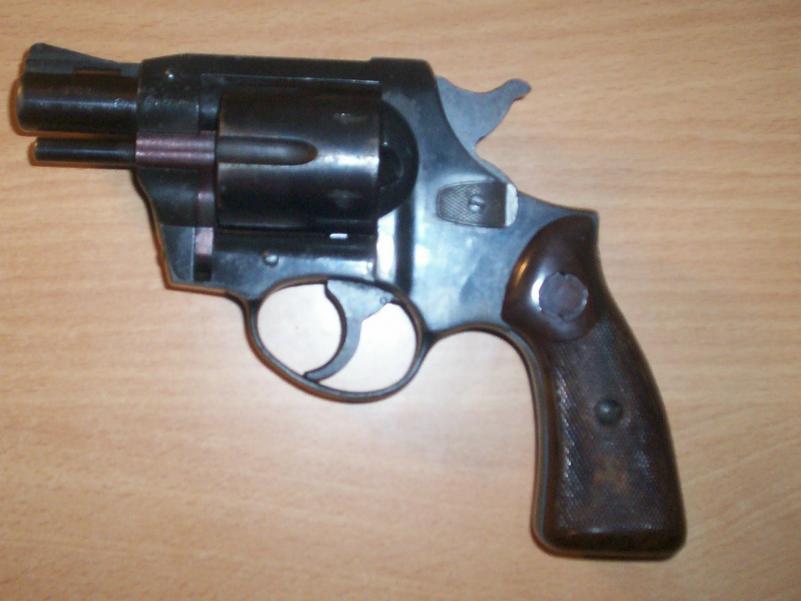
My first revolver was a Röhm GG38. Röhm (RG), like that shown above, and which was and is often referred as simply a RG38, which is a German brand of firearms and related shooting equipment that somehow somebody thought that it would be a good idea to bring to the stores of America. The revolver was heavy, the trigger was heavy, and with a 2-inch barrel teeter-tottered on being a SNS (Saturday Night Special). I can’t say that it was accurate beyond the front sight, because the revolver shot MOB (Minute Of Barn). But it was all that I could afford at the time and it was primarily to be used for close-quarters protection; make that bad-breath distance. Many of my pistols and revolvers since have had fixed sights, or shall I say semi-adjustable sights, and fully-adjustable rear sights as well. I really thought that I was ‘uptown’ when I purchased my first revolver with a truly fully-adjustable rear sight. Sheesh! Even rifles had adjustable rear sights, and there would have been a lot of wailing and gnashing of teeth and going full apoplectic by hunters and target shooters alike had adjustable sights not been on rifles! Hand gunners? Hand gun shooters are already handicapped, so why handicap us more with fixed sights? Why? Because hand gun shooters are not wimpy, whiney types like long gun shooters, and we don’t complain like those rifle snob types. We take what we have, and we make it work; that adapt and conquer thing!
I am not saying that fixed sights are bad, but they are just not as accommodating to the shooter as a set of fully adjustable sights. Most fixed sights these days are semi-adjustable in that they are dove-tail mounted and can be drifted for windage but not for elevation. However, there are still many sights that are fixed, such as with small revolvers with a machined-groove for a rear sight, single-action replica revolvers, and with some pistols. With that said, there are many pistols with fixed sights that are well-regulated for an intended load. For example, the ‘standard’ load for a Government model 1911 is a 230-grain FMJ cartridge. The 1911 pistol was originally regulated to hit a bullseye target at fifty yards with a 6 o’clock hold with fixed sights. Most handguns these days are as closely regulated to a certain distance with a certain load as closely as possible by the manufacturer, who is really supposed to know about these things. However, a shooter who is not as accurate as a Ransom Rest may not use the ammunition for which the handgun was regulated. The shooter blames the gun and the manufacturer blames the shooter or the shooter’s choice in ammunition.
Besides, everyone knows that adjustable sights are only useful for target shooting, when you want to adjust for a certain load of ammunition, and for when you want to set the sight picture best suited for you. Fixed sights are fine for a self-defense handgun because of how quickly you need to gain your sight picture or target when shooting in a self-defense situation. If you accept this line, I have a bridge in the Mohave Desert to sell you.
In the past, an adjustable rear sight was usually bulky as they were intended for target shooting and not for defensive purpose. A fear of snagging an adjustable rear sight on clothing, a holster, or whatever was perpetuated by experts and low-profile ‘combat’ fixed rear sights became the norm. However, today’s adjustable rear sight is a lot more compact then ‘back then’ and appear in ‘standard’ target sight and ‘low profile combat’ sight configurations.
When Ruger brought out the SR1911 in 2011, the first version came with Heine fixed rear sight that could be drifted for windage, as shown below.
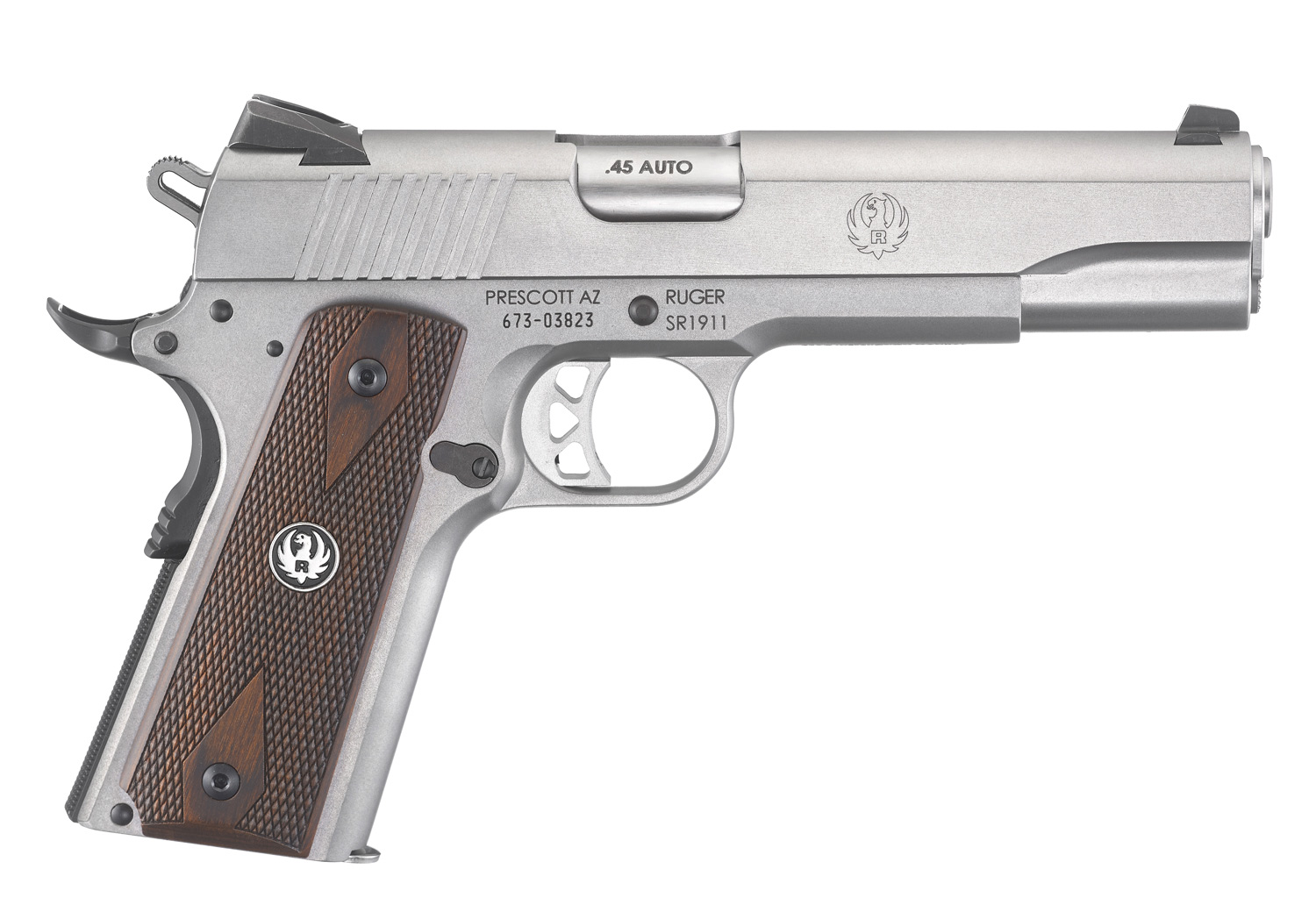
A target version came out later with a fully adjustable target rear sight, as shown below.
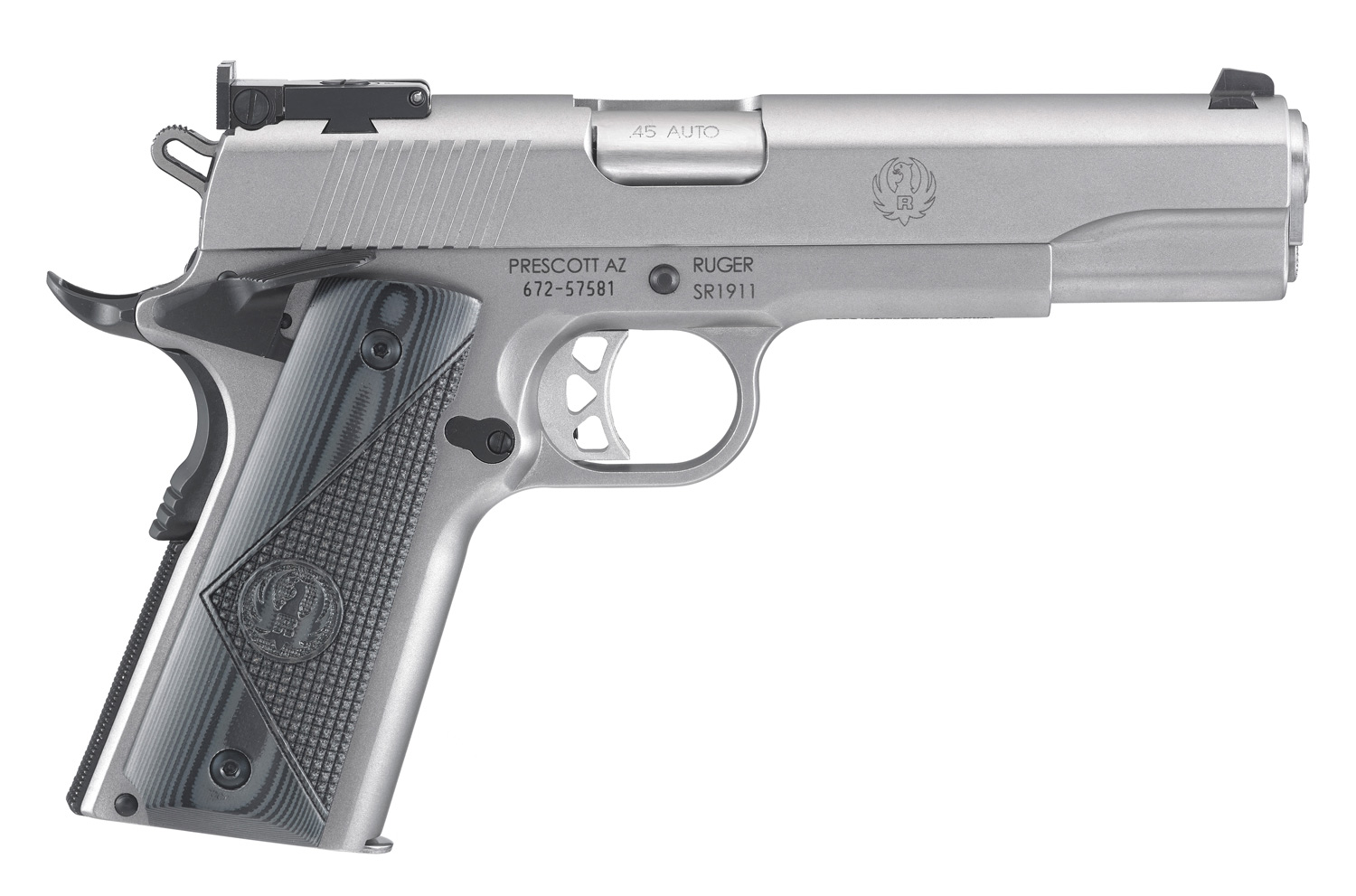
While the sight on the fixed-sight version is the preferred ‘combat’ sight, the sight on the target version is perfectly acceptable and, in fact, could be the better sight for some.
Shown below is a set of Dawson low-profile adjustable sights for the Glock pistol.
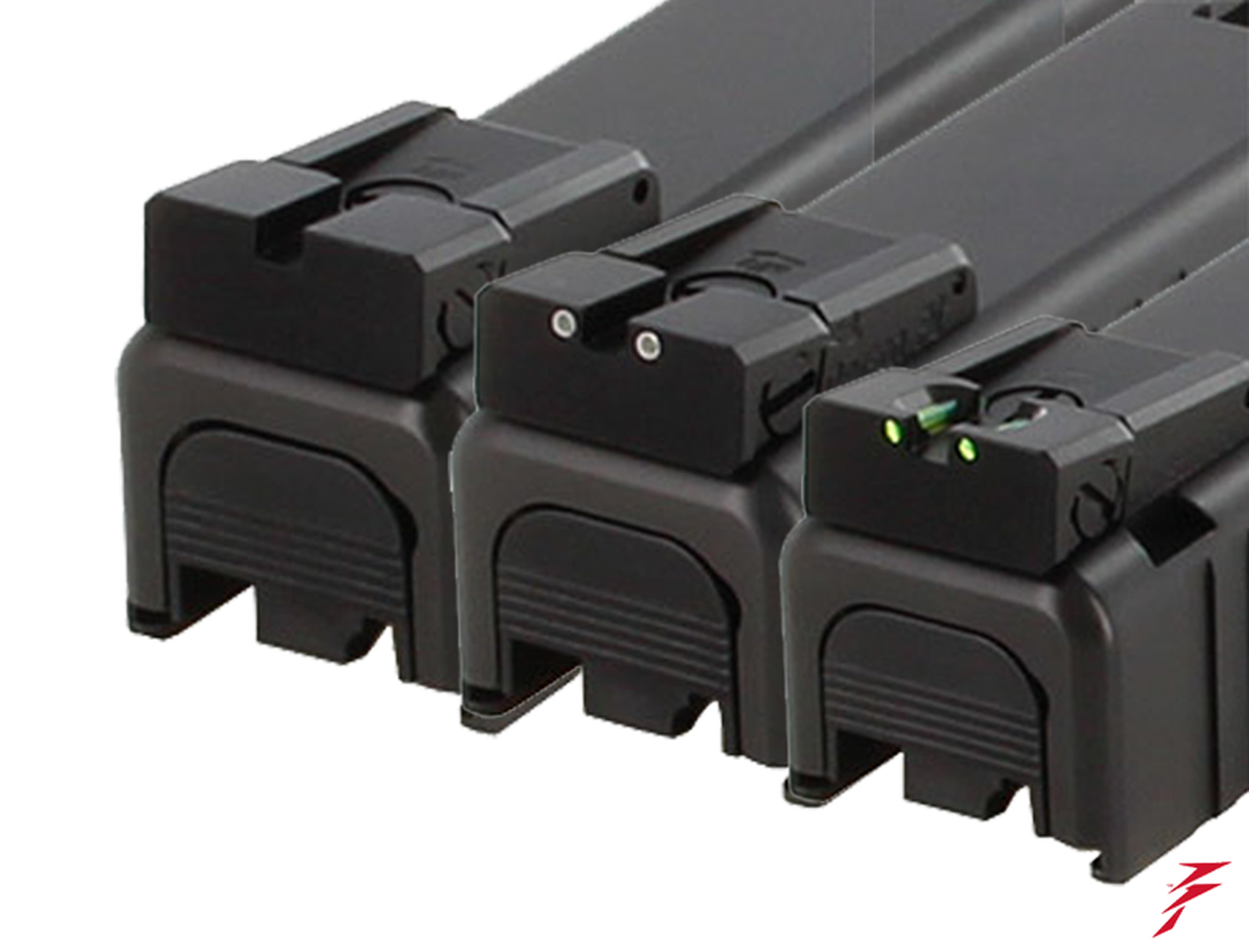
The Rock Island Armory “Ultra” series of 1911 pistols come standard with an adjustable rear sight, as shown below, and that is similar in appearance to the Dawson sights for the Glock.
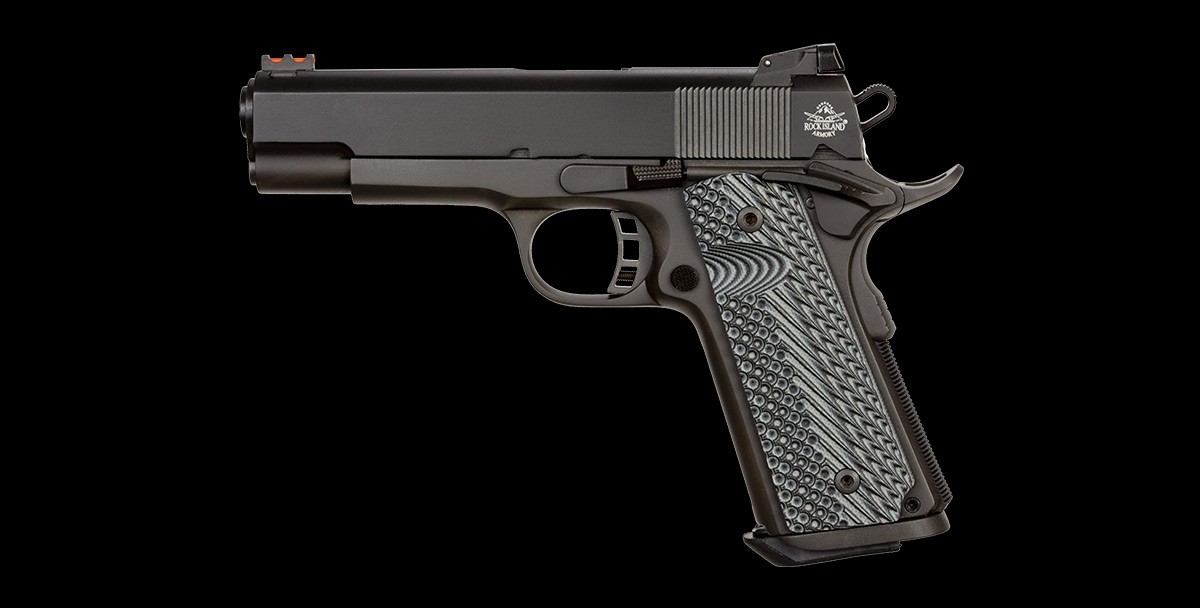
Realistically, to get your handgun to shoot where you aim, you need adjustable sights. It is usually easier and less of a bother to buy a handgun that comes with adjustable sights than it is to replace the inferior fixed sights on a model that doesn’t. However, the design of many fixed sight handguns does not even allow sight replacement without serious gun smith work, if at all. When shopping for your next handgun, sight type should be a factor in your buying decision.
Some folks will argue that at contact distance or for point shooting you don’t need adjustable sights. And that is true enough, since in these very limited instances the sights are not used. However, to use your handgun at distance, you need adjustable sights. But, at what distances would you use them?
The firearm is supposed to extend the distance between the shooter and the target. In the case of a defensive firearm, to stay out of the range of impact weapons. You want to stop an attack by a hostile person, whether human or animal, reliably and well beyond the distance at which it can do you harm. This requires accurate, not approximate, bullet placement.
An argument against an adjustable rear sight is that it is more fragile than a fixed rear sight. There may be some truth in that, depending on the type of sights being compared. A rear sight consisting of a groove in the frame is undoubtedly more impact resistant than most adjustable sights. However, you would need to drop your handgun directly on its rear sight blade, from a considerable height, onto a hard surface to do any severe damage to the sight.
Let’s go back to the fixed rear sight for a bit. My current EDC, the Rock Island Armory 1911 FS Tactical was shooting low when I first shot it, although the windage was spot on. With an adjustable rear sight, a simple adjustment would have fixed this. The pistol; however, has a fixed rear sight. To raise the point of impact, I would need to raise the rear sight or lower the front sight. Since I had no way to raise the rear sight, the latter is what I chose to do. The front sight has a front slope to it and I ‘EWAGged’ how much I needed to take off the top of the front sight in order to bring the POI up. EWAG is an “Educated Wild A_ _ Guess’ by the way.

A week passed and I was able to file the front sight down to the exact dimension that I needed according to the most advanced calculations known to man, which means that I eye-balled it. Essentially, the front rearward slope of the front sight was lowered so that the top of the front sight was parallel with the slide. After that was done, the face of the front sight was painted with a white base-coat and then fluorescent red to make the front slope stand out a little better than it did before. Additionally, the top of the front sight, which had to be filed down, had to be painted and a coat of flat black took care of that. The next trip to the range told the tale. Aiming just a “shy high” of the bull was resulting in a series of holes appearing within the bulls-eye. In other words, cover what I want to hit with the barrel, pull the trigger, the skies part, thunder rolls, and .45 caliber holes appear near where I want them to – if I do my part. I considered the Rock Island Armory 1911 FS Tactical “duty ready” at that point.
Below is a comparison between the Rock Island Armory 1911 FS Tactical (right) and the Glock G34 GEN5 MOS (left) that is equipped with a Glock adjustable target rear sight. As far as rear sight height, there is little difference.
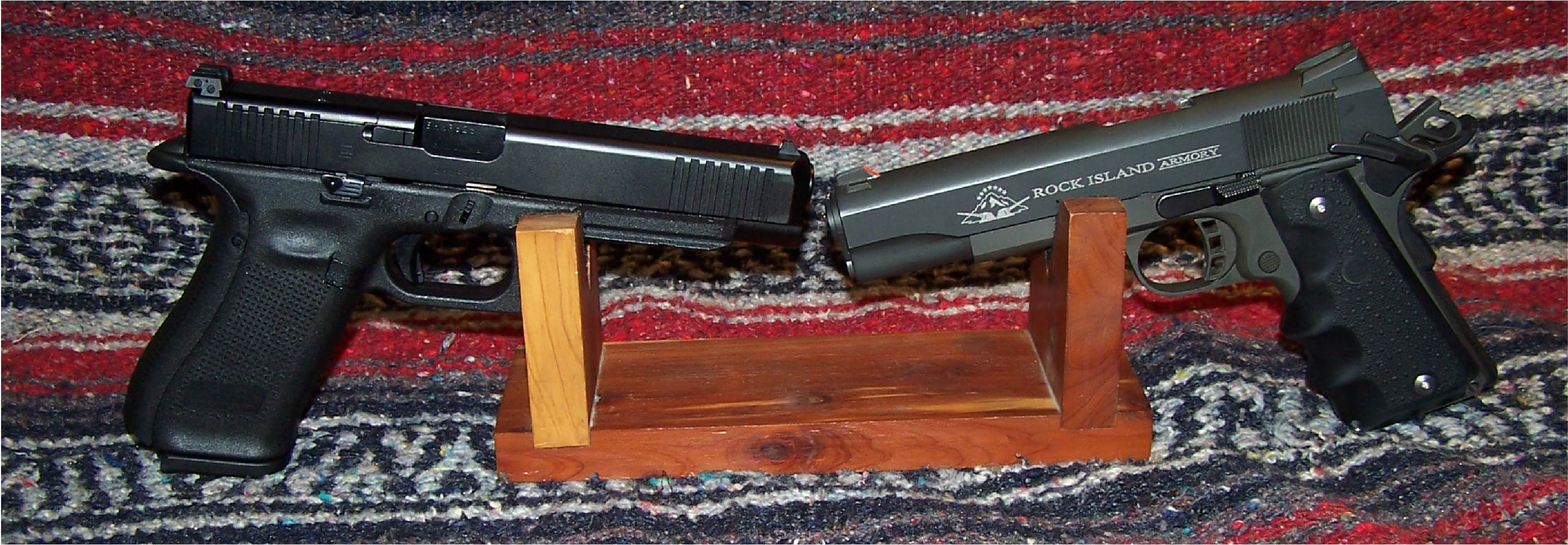
As you can tell from the picture below of a Springfield Armory XDM 5.25 Competition model in 9mm, the manufacturer has done an excellent job of keeping the rear adjustable sight as low-profile as possible.

If I shot only one pistol, the Rock Island Armory 1911 FS Tactical, there would be no need to worry about things further. However, I shoot quite a few firearms as I prepare reviews for them. I recently fired a Springfield Armory XDM 10mm with a 5.25-inch barrel. With the chosen ammunition I was shooting slightly left, although elevation was a 6 o’clock hold. Four clicks of right windage solved the issue. If I use this same ammunition (Sig Sauer V-Crown 180-grain JHP), I should have no issues hitting what I am aiming at. However, if I move to a 165-grain, or a 200-grain cartridge, I will have to re-zero the firearm to that ammunition. Again, it should only take a couple clicks of adjustment to move the point of impact where I want it. Otherwise, I get to play the “Kentucky Sighting” game and figure out where to hold to get the desired POI, and that is not something that I want to worry about if I ever must use this firearm defensively.
I could shoot a dozen different pistols and they will all have a different POA vs. POI with the same ammunition. Finding ammunition that provide the best accuracy and reliability is only the first part of the equation. While you cannot “tailor’ the ammunition to the gun, the gun must be tailored to the ammunition, and that’s is where ‘regulation’ comes in to play. For most of us with fixed sights, that means get it close. With adjustable sights, t means you can get it as close as possible. (Author’s Note: While you can tailor ammunition to your gun, for a firearm that is used for self-defense, this is not a good thing to do from a liability standpoint.)
Going back to the defensive distance, most ammunition for a given pistol will impact in the same proximity regardless of the projectile’s weight at a combat distance of seven yards (21 feet). It’s when the distance lengthens that we see the differences between cartridges of the varying bullet weights. Let’s look at some rough figures.
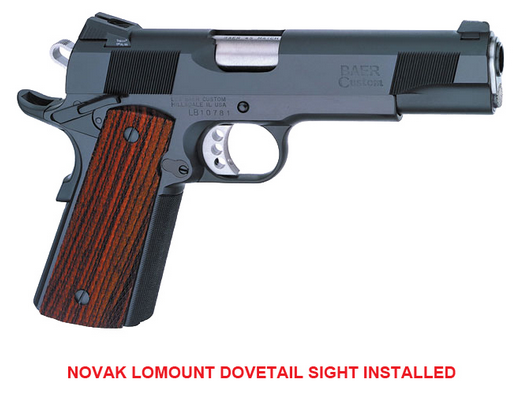
Let’s say that the bullet from your pistol is impacting point of aim at 7 yards. You could then consider that as your zero distance with your ammunition. For giggles, let’s say that you are shooting a 9mm pistol with 115-grain Hydra-Shok ammunition. So, you then take a shot at twenty-five yards. Ballistically, you should be about 3.11 inches high. At fifty yards, you would be (ballistically) 6.21 inches high.
Let’s say that you want to try some 147-grain Hydra-Shok ammunition. Your zero will still be at seven yards for the most part. Taking that shot at twenty-five yards now results in an impact 2.78 inches high. A fifty-yard shot yields an impact 4.66 inches high.
Of course, there are a lot of variables to be factored into this; for example, sight height. The sight height for the data was .15 inches. Your pistol or revolver sights may be higher or lower.
Now, all of this was nice, but is it necessary? While it is good to know what your firearm is capable of with your choice of ammunition. It is more important to know what the zero is for your pistol with your choice of ammunition, or what ammunition works best in your firearm. If you want your POI to be your POA at a certain distance, and your pistol is not delivering that (if you are doing everything right), then an adjustable rear sight just might be the answer.
What if you wanted your zero to be at twenty-five yards or at fifty yards? Would you rather have to adjust your sight picture on the fly, or simply dial it in? Let’s say that your selected defense load is the Federal 9mm 124-grain HST and you decide to zero at 50 yards. You fire your first 5-shot group and it low but centered. No problem, a little elevation adjustment of raising the rear sight brought you right on target, as demonstrated by the next 5-shot group. So now that you are zeroed at fifty yards, what happens when you must take that 7-yard shot. Well, according to the data below, you might only be 0.25-inches or so low.
Looking further, let’s say that you decide to change your zero to the “combat” distance of 7-yards. No problem to simply adjust the rear sight until your group is where you want it at 7-yards. That is, if you have an adjustable rear sight. If you had to take a 25-yard shot, simply raise your point of aim .25 inches high. For a fifty-yard shot, raise you sight picture to around 2-inches high to hit your desired target. And to be somewhat of a defeatist, nobody that I know of can make these fine sight adjustments on the fly, but I am sure that there are some who can.

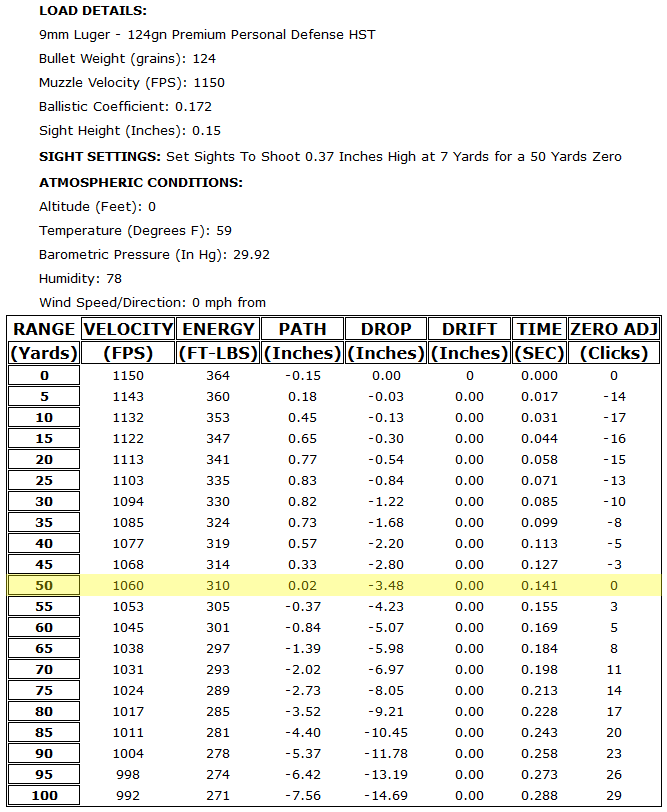
The distance of seven yards (21 feet) seems to be the de facto combat distance. Most events happen quickly, and you won’t have time to take a careful aim; in short, it will be point and pull. But when you do have time to aim, it’s to your advantage to know where your rounds are going to impact relative to your point of aim at a given distance. At distance between your muzzle and twenty-five yards, there is not much flight path deviation. But the flight path depends on what you are doing while holding the firearm and what dynamics are taking place between the time you start pulling the trigger until the bullet leaves the muzzle. A zero, nor sights, means nothing if you have developed a flinch. I want as many advantages in my court as possible, and if an adjustable rear sight can help me with that, I am good with it.

Let’s throw in another dynamic, the bad person who is intent on doing you or yours harm. They are dynamic just like you are. Their attack, most often, is based on surprise and ambush tactics. However, if your situational awareness has been honed, that may take away the surprise from the bad person and put it in your corner. The bad person (or people) may have mis-read you, took you for a victim, when in fact you were just the opposite. You may be fortunate that when you pull your PDA, the bad people run away. Or they just might want to test your mettle, or they might be in a way, due to their favorite recreational drug, to simply not care about you or what you have. They just want to hurt you. In these cases, you may not even need sights on your PDA, because this is going to be up close and personal.
I rarely venture out at night anymore. And when I do, I tend to stay in well-lighted areas. I really must rely on backlighting or parking lot lighting, as my EDC is without night sights (fixed or adjustable). In most cases, I would not need them, as I have spent many hours behind sights with little or no definition to them except for an outline.
Some pistol manufacture’s, like Glock, offer different heights of front sights. These sights are very easy to change using the Glock Front Sight Tool. Ruger used to offer different front sights for their GP100 (I exchanged the ramp front sight on my GP100 with a fiber front sight, which did not require a rear sight adjustment (my GP100 has an adjustable rear sight)). Some sights are easy to change while other require a gunsmith, and your time away from the firearm.
What I am trying to get at here is that adjustable rear sights make it easier to adjust your point of aim to the firearms point of impact at your desired zero distance, within reason. Since the 7-yard standard still applies, I want my POI to be my POA at that distance. If I need to take a fist-sized heart shot at that distance, or a head shot at that distance, I need to be spot on to achieve that and I am not going to have the time to adjust my sight picture to another POA to achieve the necessary POI. In short, what I point at I want to it, and if having an adjustable rear sight that will help me do that, then that’s the recipe that I need to follow.
If I need to take a shot at 20 yards, I will still be within my 1” window of opportunity to place the shot where I need it placed. At fifty yards, I would be out of my 1” comfort zone at taking a shot in a defensive situation, and I would have to use a bit of hold-over. In truth, as a civilian, if I should find myself in a fifty yard firefight, I am very stupid for not leaving the situation in the first place. However, this could be an active ‘killer’ situation where I might have to take that fifty yard shot to save the lives of others, and perhaps myself. In my case, the possibility would be slim, but I am not going to discount it entirely either. Anything can happen at anytime.
Again, factory sight setups are usually pretty close, but they are not perfect, and in fact may not even be ideal for your purpose. That new revolver that you just fired was supposed to be accurate, but it’s not, because it is not even close to hitting where you are aiming. Most experienced shootist will understand the dynamics in play, sort through the various possibilities, and come up with a solution. Inexperienced shootist do not have the experience to sort through all the dynamics in play. Dialing in a firearm takes patience, and those who are looking for instant gratification do not have patience, and that is sometimes a plus for us with experience, because we may get to buy the firearm they can’t shoot for a very decent price.
A Parting Look
I would not disregard the purchase of a firearm with an adjustable rear sight if the firearm is going to fit within my schema of use. You just need to determine if the convenience of having an adjustable rear sight is worth your time. Now if you will excuse me, I am going to investigate these Dawson low-profile adjustable sights for the Glock pistol.
![]()


3 Responses to HANDGUN SIGHTS – FIXED OR ADJUSTABLE?